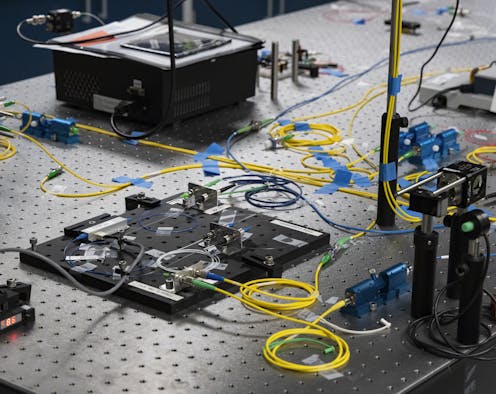
Unhackable communications devices, high-precision GPS and high-resolution medical imaging all have something in common. These technologies – some under development and some already on the market all rely on the non-intuitive quantum phenomenon of entanglement.
Two quantum particles, like pairs of atoms or photons, can become entangled. That means a property of one particle is linked to a property of the other, and a change to one particle instantly affects the other particle, regardless of how far apart they are. This correlation is a key resource in quantum information technologies.
For the most part, quantum entanglement is still a subject of physics research, but it’s also a component of commercially available technologies, and it plays a starring role in the emerging quantum information processing industry.
Pioneers
The 2022 Nobel Prize in Physics recognized the profound legacy of Alain Aspect of France, John F. Clauser of the U.S. and Austrian Anton Zeilinger’s experimental work with quantum entanglement, which has personally touched me since the start of my graduate school career as a physicist. Anton Zeilinger was a mentor of my Ph.D. mentor, Paul Kwiat, which heavily influenced my dissertation on experimentally understanding decoherence in photonic entanglement.
Decoherence occurs when the environment interacts with a quantum object – in this case a photon – to knock it out of the quantum state of superposition. In superposition, a quantum object is isolated from the environment and exists in a strange blend of two opposite states at the same time, like a coin toss landing as both heads and tails. Superposition is necessary for two or more quantum objects to become entangled.
Entanglement goes the distance
Quantum entanglement is a critical element of quantum information processing, and photonic entanglement of the type pioneered by the Nobel laureates is crucial for transmitting quantum information. Quantum entanglement can be used to build large-scale quantum communications networks.
On a path toward long-distance quantum networks, Jian-Wei Pan, one of Zeilinger’s former students, and colleagues demonstrated entanglement distribution to two locations separated by 764 miles (1,203 km) on Earth via satellite transmission. However, direct transmission rates of quantum information are limited due to loss, meaning too many photons get absorbed by matter in transit so not enough reach the destination.
Entanglement is critical for solving this roadblock, through the nascent technology of quantum repeaters. An important milestone for early quantum repeaters, called entanglement swapping, was demonstrated by Zeilinger and colleagues in 1998. Entanglement swapping links one each of two pairs of entangled photons, thereby entangling the two initially independent photons, which can be far apart from each other.
Quantum protection
Perhaps the most well known quantum communications application is Quantum Key Distribution (QKD), which allows someone to securely distribute encryption keys. If those keys are stored properly, they will be secure, even from future powerful, code-breaking quantum computers.
While the first proposal for QKD did not explicitly require entanglement, an entanglement-based version was subsequently proposed. Shortly after this proposal came the first demonstration of the technique, through the air over a short distance on a table-top. The first demonstrations of entangement-based QKD were published by research groups led by Zeilinger, Kwiat and Nicolas Gisin were published in the same issue of Physical Review Letters in May 2000.
These entanglement-based distributed keys can be used to dramatically improve the security of communications. A first important demonstration along these lines was from the Zeilinger group, which conducted a bank wire transfer in Vienna, Austria, in 2004. In this case, the two halves of the QKD system were located at the headquarters of a large bank and the Vienna City Hall. The optical fibers that carried the photons were installed in the Vienna sewer system and spanned nine-tenths of a mile (1.45 km).
Entanglement for sale
Today, there are a handful of companies that have commercialized quantum key distribution technology, including my group’s collaborator Qubitekk, which focuses on an entanglement-based approach to QKD. With a more recent commercial Qubitekk system, my colleagues and I demonstrated secure smart grid communications in Chattanooga, Tennessee.
Quantum communications, computing and sensing technologies are of great interest to the military and intelligence communities. Quantum entanglement also promises to boost medical imaging through optical sensing and high-resolution radio frequency detection, which could also improve GPS positioning. There’s even a company gearing up to offer entanglement-as-a-service by providing customers with network access to entangled qubits for secure communications.
There are many other quantum applications that have been proposed and have yet to be invented that will be enabled by future entangled quantum networks. Quantum computers will perhaps have the most direct impact on society by enabling direct simulation of problems that do not scale well on conventional digital computers. In general, quantum computers produce complex entangled networks when they are operating. These computers could have huge impacts on society, ranging from reducing energy consumption to developing personally tailored medicine.
Finally, entangled quantum sensor networks promise the capability to measure theorized phenomena, such as dark matter, that cannot be seen with today’s conventional technology. The strangeness of quantum mechanics, elucidated through decades of fundamental experimental and theoretical work, has given rise to a new burgeoning global quantum industry.
Nicholas Peters receives funding from The United States Department of Energy (DOE) Office of Science Advanced Scientific Computing Research program and DOE's Office of Cybersecurity, Energy Security and Emergency Response. He is affiliated with Oak Ridge National Laboratory.
This article was originally published on The Conversation. Read the original article.







